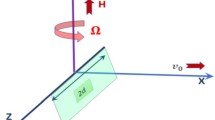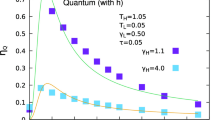Abstract
The \(3\omega \) method may be used to estimate the thermal conductivity of an electrically conducting wire. In this method, an alternating voltage with an angular frequency \(\omega \) is applied to the wire. The resulting low electrical tension \(U_{3\omega }\) of angular frequency \(3\omega \) that appears in the total electrical tension is extracted by a lock-in amplifier. The amplitude of \(U_{3\omega }\) is directly linked to the thermal conductivity of the wire and enables its estimation. All authors using the \(3\omega \) method for the determination of the thermal conductivity of an electric conducting wire considered that the heat flux produced by Joule effect in the wire is constant. This hypothesis leads to a linear form of the heat transfer equation. In this work, an analytical model taking into account the dependence of the heat flux on the temperature is developed, it leads to a non-linear form of the heat transfer equation. The importance of the non-linearity in certain cases is demonstrated and the analytical solution is used to define a unique criterion that must be verified to ensure the validity of the linear solution.









Similar content being viewed by others
References
Corbino OM (1910) Thermal oscillations in lamps of thin fibers with alternating current flowing through them and the resulting effect on the rectifier as a result of the presence of even-numbered harmonics. Phys Z 11:413–417
Rosenthal LA (1961) Thermal response of bridewire used in electroexplosive devices. Rev Sci Instrum 32(9):1033–1036
Holland LR (1963) Physical properties of Titanium. III. The specific heat. J Appl Phys 34(8):2350–2357
Birge NO, Nagel SR (1985) Specific-heat spectroscopy of the glass transition. Phys Rev Lett 544(3):2674–2677
Birge NO, Nagel SR (1987) Wide-frequency specific heat spectrometer. Rev Sci Instrum 58(8):1464–1470
Birge NO, Dixon PK, Menon N (1997) Specific heat spectroscopy: origins status and applications of the \(3\omega \) method. Thermochim Acta 304(305):51–66
Frank R, Drach V, Fricke J (1993) Determination of thermal conductivity and specific heat by a combined \(3\omega \)/decay technique. Rev Sci Instrum 64(3):760–765
Cahill DG (1990) Thermal conductivity measurement from 30 to 750 K: the \(3\omega \) method. Rev Sci Instrum 61(1):802–808
Cahill DG (1989) Thermal conductivity of thin films: measurements and understanding. Vacuum Sci Technol A 7(3):1259–1266
Lee S-M, Cahill DG (1997) Heat transport in thin dielectric film. J Appl Phys 81(6):2590–2595
Lu L, Yi W, Zhang DL (2001) \(3\upomega \) method for specific heat and thermal conductivity measurements. Rev Sci Instrum 72(7):2996–3003
Dames C, Chen G (2005) \(1\upomega \), \(2\upomega \) and \(3\upomega \) methods for measurements of thermal properties. Rev Sci Instrum 76:124902
Wang ZL, Tang DW, Zhang WG (2007) Simultaneous measurements of the thermal conductivity, thermal capacity and thermal diffusivity of an individual carbon fiber. J Phys D: Appl Phys 40:4686–4690
Bhatta RP, Annamalai S, Mohr RK, Brandys M, Pegg IL, Dutta B (2010) High temperature thermal conductivity of platinium microwire by \(3\upomega \) method. Rev Sci Instrum 81(11):114904
Huzel D, Reith H, Schmitt MC, Picht O, Müller S, Toimil-Molares ME, Völklein F (2011) Characterization and application of thermoelectric nanowires, Chap. 14. In: Hashim A (ed) Nanowires - implementations and applications. IntechOpen
Kimling J, Martens S, Nielsch K (2011) Thermal conductivity measurements using \(1\upomega \) and \(3\upomega \) methods revisited for voltage-driven setups. Rev Sci Instrum 82:074903
Choi TY, Poulikakos D, Tharian J, Sennhauser U (2005) Measurement of thermal conductivity of individual multiwalled carbon nanotubes by the 3-\(\upomega \) method. Appl Phys Lett 87:013108
Bourgeois O, Fournier T, Chaussy J (2007) Measurement of the thermal conductance of silicon nanowires at low temperatures. Appl Phys 101(1):016104
Moon J, Weaver K, Feng B, Chae HG, Kumar SZ, Balk JB, Peterson GP (2012) Thermal conductivity measurement of individual poly (ether ketone)/carbon nanotube fibers using a steady-state DC thermal bridge method. Rev Sci Instrum 83:1–3
Depasse F, Grossel Ph, Trannoy N (2004) Probe temperature and output voltage calculation for the SThM in AC mode. Superlattice Microstruct 35:315–322
Xing C, Jensen C, Munro T, White B, Ban H, Chirtoc M (2014) Thermal property characterization of fine fibers by the \(3\upomega \) technique. Appl Therm Eng 71:589–595
Hou J, Wang X, Vellelacheruvu P, Guo J, Liu C, Cheng HM (2006) Thermal characterization of single wall carbon nanotube bundle using the self-heating \(3\upomega \) technique. J Appl Phys 100:124314
Duffy DG (2001) Green’s functions with applications. CRC Press, Boca Raton
Author information
Authors and Affiliations
Corresponding author
Additional information
Publisher's Note
Springer Nature remains neutral with regard to jurisdictional claims in published maps and institutional affiliations.
Rights and permissions
About this article
Cite this article
Ding, T., Jannot, Y., Schick, V. et al. Analysis of the non-linearity of the heat transfer equation in case of a time-dependent heat source: application to the \(3\omega \) method. J Eng Math 121, 85–99 (2020). https://doi.org/10.1007/s10665-020-10040-z
Received:
Accepted:
Published:
Issue Date:
DOI: https://doi.org/10.1007/s10665-020-10040-z




